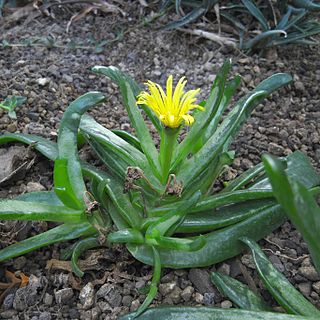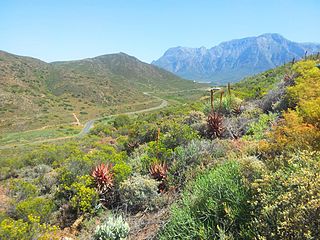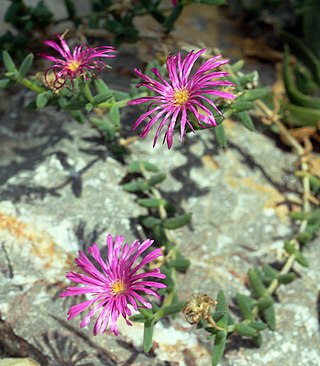
The Aizoaceae, or fig-marigold family, is a large family of dicotyledonous flowering plants containing 135 genera and about 1800 species. Several genera are commonly known as 'ice plants' or 'carpet weeds'. The Aizoaceae are also referred to as vygies in South Africa and New Zealand. Some of the unusual Southern African genera—such as Conophytum, Lithops, Titanopsis and Pleiospilos —resemble gemstones, rocks or pebbles, and are sometimes referred to as 'living stones' or 'mesembs'.

Lampranthus is a genus of succulent plants in the family Aizoaceae, indigenous to southern Africa.

Mesembryanthemum is a genus of flowering plants in the family Aizoaceae, indigenous to southern Africa. As with many members of that family, it is characterized by long-lasting flower heads. Flowers of Mesembryanthemum protect their gametes from night-time dews or frosts but open in sunlight. There is an obvious evolutionary advantage to doing this; where sun, dew, frost, wind or predators are likely to damage exposed reproductive organs, closing may be advantageous during times when flowers are unlikely to attract pollinators.
Antimima eendornensis is a species of plant in the family Aizoaceae. It is endemic to Namibia. Its natural habitats are subtropical or tropical dry shrubland and rocky areas. It is threatened by habitat loss.

Juttadinteria is a genus of plants in the family Aizoaceae.

Ruschia is a genus of succulent plant, in the family Aizoaceae, indigenous to the dryer parts of southern Africa.

Drosanthemum ("dewflowers") is a genus of succulent plants in the ice plant family native to the winter-rainfall regions of southern Africa, including Namibia and the Cape Provinces and Free State of South Africa. Most species bear colorful flowers.

Glottiphyllum is a genus of about 57 species of succulent subtropical plants of the family Aizoaceae. It is closely related to the Gibbaeum and Faucaria genera. The name comes from ancient Greek γλωττίς glottis "tongue" and φύλλον phyllon "leaf". The species are native to South Africa, specifically to Cape Province and the Karoo desert. They grow in rocks and soils incorporating slate, sandstone and quartz. Rainfall in their native areas is between 125 and 500 mm, most of which falls in March and November.

Chasmatophyllum is a genus of succulent plants native to South Africa, Lesotho, and Namibia in southern Africa.

Robertson Karoo is a semi-arid vegetation type, restricted to sections of the Breede River Valley, Western Cape Province, South Africa. It is a subtype of Succulent Karoo and is characterised by the dominance of succulent plant species, and by several endemic plants and animals.

Acrodon is a genus of ice plants from South Africa. It comprises five species, mostly endangered and all restricted to the southern Cape regions of the Western Cape and Eastern Cape Provinces, South Africa.
Ruschia leptocalyx is a species of succulent plant in the family Aizoaceae. It is endemic to the Cape Provinces of South Africa, where its natural habitat is in rocky renosterveld vegetation in the southern Cape.

Trichodiadema barbatum is succulent plant of the genus Trichodiadema, native to the Eastern Cape Province, South Africa.

Vanheerdea is a genus of flowering plants belonging to the family Aizoaceae. It is also in Tribe Ruschieae.

Pleiospilos compactus, called living rock, is a species of flowering plant in the ice plant genus Pleiospilos, native to the southwestern Cape Provinces of South Africa. A succulent, it has gained the Royal Horticultural Society's Award of Garden Merit.
Eberlanzia is a genus of flowering plants belonging to the family Aizoaceae.
Hallianthus is a monotypic genus of flowering plants belonging to the family Aizoaceae. It only contains one species, Hallianthus planus
Leipoldtia is a genus of flowering plants belonging to the family Aizoaceae.

Schlechteranthus is a genus of flowering plants belonging to the family Aizoaceae.














